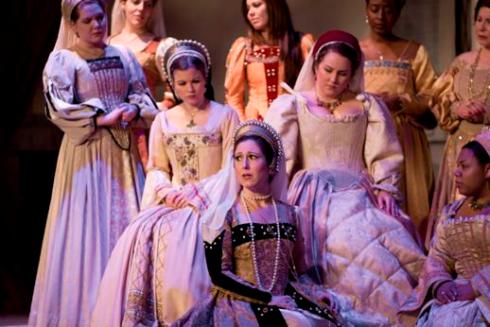By JOHN DeMERS
As a card-carrying member of opera’s Old Chestnuts (big thanks here to my late father, who made me invariably think of them as that), Giuseppe Verdi’s La Traviata has many reasons for being produced worldwide, year after year, and indeed century after century.
For starters, it’s one of the art form’s rare stories that everybody can believe and invest in. Though set in glittering Paris of the 1800s, it portrays elements of romantic love that most have experienced in their own lives. According to opera history, Verdi himself was experiencing a similar story just as he was setting Alexandre Dumas’ La Dame aux Camelias to his own brand of stirring, passionate, lyrical music. Maybe it helped. For another thing, La Traviata’s front-and-center role of courtesan Violetta Valery has a wonderful way of creating divas, the kind based on art instead of attitude.
That, more or less, is what happened last night at Houston Grand Opera’s moving (if intellectually strained) production. In that age-old showbiz tradition, Russian-born soprano Albina Shagimuratova walked onto the Wortham Center stage as a singing actress, and left it close to three hours later as a star. All members of the cast received enthusiastic applause, especially since many understood that tenor Bryan Hymel had been called in to take over the male lead something like three days earlier. But that unique Texas blend of classy “Brava!” and hootin’ and hollerin’ was reserved for Shagimuratova, who has been embraced as “local artist” since her days with HGO Studio.
Despite barriers thrown up by British director Daniel Slater, last seen here with Lohengrin in 2009, this Violetta was everything one should be, both dramatically and vocally. She seemed alternately filled with bravado and vulnerability, a woman who seems to know she’s dying more than in some productions but who reacts to this and rages against it with heartbreaking intensity. For once given coloratura fireworks that paint character rather than simply show off singing, Shagimuratova displayed an almost-breakable wonder in each and every note. Her Act I anthem, “Sempre libera,” was a showstopper. And by the end, as Violetta breathes her last in the odd manner Slater devised, no one watching could doubt she truly loved this young man Alfredo, that she made the sacrifice she makes for him out of love, and that she prays God will thank her with the forgiveness she seeks with a checked past but a pure, penitent heart.
Born in New Orleans but a veteran of opera houses across Europe, including La Scala in Milan and Covent Garden in London, Hymel delivered a convincing presence to the role of Alfredo, his sufferings at the hands of his life’s great love very close to the surface. When, on her deathbed, Violetta prays that he will find a beautiful young girl and marry her, it was all the audience could manage not to shout “No!” right along with him. Hymel’s singing was impassioned and technically first-rate, a particular joy in his Act I “Brindisi” drinking song and his duets with Violetta. Giovanni Meoni was terrific as Alfredo’s father, Georgio Germont – though his balding head made me nostalgic for the tufts of hair sprouting from a crumpled hat that were the late Robert Merrill’s signature in the role. Meoni took second to nobody, however, when singing his famous lyrical invitation for his son to leave a life of sin and return home, “Di Provenza il Mar.”
Now, about Slater’s direction… It’s starts out cinematic and logical enough, using the brittle sighs of Verdi’s overture (brilliantly drawn out by music director Patrick Summers) as a present frame for a past narrative. In movie terms, this opening dissolves into an extended flashback. Yet within that completely effective and non-intrusive storytelling trick, Slater intrudes again. And again. And again.
Unsatisfied with flashing back, or even giving Violetta a lookalike ghost to haunt her with approaching death and the occasional camelia, this director from time to time paints the flashback as being driven half-mad by the woman’s fevers. Her ever-celebrating friends, in this production, slink and slither around ballrooms in ways that are interesting as choreography but not helpful, and even Alfredo himself gets caught up in some kind of hallucination later on, a fantasy about matadors and bulls. At least Slater got the second part right.
By the time Violetta is due to collapse and die, she walks instead across the open room and disappears “into the light.” New Age coolness, to be sure. Yet in the process – and really, this is what’s wrong with Slater’s device – it steals precisely what we in the audience need to see and need to feel. Any production of La Traviata, even one that turns its soprano into a star, needs to end with a lover weeping over the beloved body in his arms, not with just another guy sitting alone on a couch.
Photos by Felix Sanchez: (top) Shagimuratova and Hymel; (bottom) Shagimuratova and friends.







